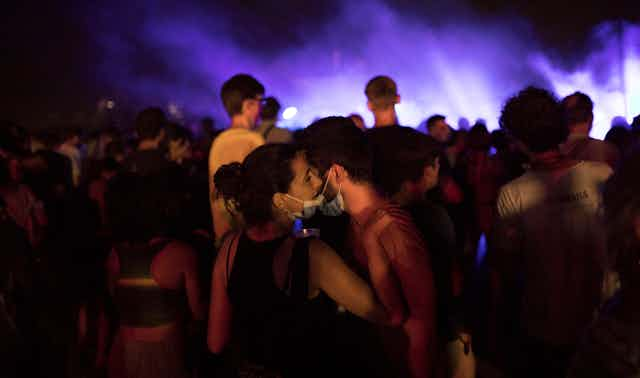As universities have reopened in various ways this fall after spring COVID-19 closures and a rapid move to online learning, new challenges are emerging. Beyond navigating a “new normal” of both virtual and in-person academic learning, universities must confront questions about student life and wellness in a pandemic.
As some students return to campuses and university communities, it’s clear that COVID-19 has not influenced a change in some student partying behaviours with the potential to spread COVID-19.
In the United States, there have been notable campus shutdowns and high COVID-19 case numbers among some post-secondary students. In Canada, an outbreak was recently declared after five Western University students tested postive for COVID-19.
Universities need to collaborate with government policy-makers to provide guidelines that acknowledge the important role socializing plays in student mental health, and that will help students find safer ways to participate in building personal networks and supports.
Transitions, challenges, mental health

Universities have relayed information and resources about how COVID-19 is impacting universities in addition to specific information about physical saftey to mitigate the risk of outbreaks. They have also emphasized encouraging student resilience, virtual orientation to student life and services and caring for mental health. Notably, however, there remain gaps in the conversation about student substance use and mental health.
In reopening after COVID-19 closures, universities have relied on their own experts and other guidelines. In Canada, they and local health authorities had guidance from from the Public Health Agency of Canada (PHAC) in collaboration with Canadian public health experts.
Some Canadian universities have issued messages warning students about rule-breaking and in Ontario, Premier Doug Ford has asked students to “cool your jets with the partying.”
Some public health researchers have noted shortcomings in the kinds of messaging used for students and young people to communicate risks of the virus and safer practices. Ideally, such messaging would acknowledge the specific realities and needs of students.
Life transitions
A typical fall semester would have both full-time commuting and non-commuting students students experiencing a dense point of transition related to their social roles and friendships. Students attending university face changes related to geography, living arrangements and lifestyle, coupled with a decrease in parental monitoring and supervision.
The transition to post-secondary campus life is commonly seen as a period of experimentation and exploration, where we see an increase in substance use and associated harms.
Students throughout the pandemic are facing precarious futures but have been asked to carry on and shoulder increased burdens as they navigate COVID-19. Universities may have to deal with new mental health concerns emerging from pandemic stressors. Feelings of being overwhelmed will likely increase as the term moves forward and workloads increase.
Alcohol consumption
My own master’s research, and other research, has shown that alcohol consumption among students matches closely with dates that have an associated culture promoting high levels of alcohol consumption, such as such as orientation or Halloween.
For students, punitive sanctions such as fines or suspensions aren’t effective, as individuals tend to view condemnation of their actions as illegitimate since they see evidence of others with similar conduct who won’t necessarily face sanctions.
Students may deflect responsibility for their actions using their peers as a shield from taking personal responsibility if they too are engaging in similar behaviours.
In the pandemic, learning how to speak to young people about risk has been shown to be critical, as abstinence-style messages aren’t effective. This challenge will only worsen as temperatures cool down. Outdoor gatherings will end and bar patios close, causing gatherings to move indoors, thus posing greater health risks.
Outdoor spaces while effective in the short-term, are limited by the changing weather. New guidelines are needed to provide students with safe spaces to congregate.

Building bonds critical for students
The initial phase of campus life is more social and changes as the term progresses. Students establish peer and study groups, engage in extra-curricular activities and activities that provide them a sense of belonging and a strong source of support. Building these bonds is essential to assist students in acclimating to the campus environment and coping with the stressors of university life.
As academic workloads increase, student stress levels increase accordingly. Even before the pandemic, campuses across the country before the COVID-19 crisis were trying to respond to record levels of anxiety and depression among the university student population.
Governments should seek to bolster university mental health services to prevent a further backlogging of the campus system and provide students the care they need to cope with the added stress of the pandemic university experience. Particular attention should be paid to students living off-campus, and finding ways to provide these students with an equal level of services and support.
In a typical semester those students on campus or living adjacent to campus already faced an advantage in forming social bonds compared to those off-campus. With fewer students on campus and students telecommuting, attempts to form social bonds will be more difficult. We must be aware of the dangers of isolation and the heightened fears related to the pandemic that students face.
Duty of care
COVID-19 has forced students to acclimatize to the new reality of university life. Students turn to their peers when dealing with mental health concerns for support which has been shown to be effective in managing anxieties.
Those able to forge strong bonds adjust to campus life more easily. Failing to address this change may heighten anxieties and lead to students having worse academic and personal outcomes as a result.
Universities need to find new ways of having students interact on and off-campus with accessible physical and virtual meeting places. Universities owe their students a duty of care to ensure that they are not just remaining safe from COVID-19 but, that they are still able to learn and grow from the valuable experiences that post-secondary life brings inside and outside the classroom.

